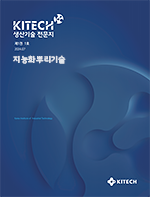저자 소개
We aim to find a solution to emerging the environmental issues through
- Rational design and fabrication of functional nanofiber-based membrane with desired properties and structure.
- Recycling and upcycling of synthetic polymer via physical/chemical treatment.
- Understating properties and behaviors of natural polymers for broadening its application and replacing synthetic polymers.
- Development of membrane-based filtration system for environmental remediation.
- Development of polymeric material for resource recovery.
학력 / 경력 정보
- 2004-2009한양대학교 이학사
- 2009-2015한양대학교 박사
활동내역
-
논문
Optimizing Cellulose Acetate Microbead Formation through Premixed Membrane Emulsification: Unraveling Critical Parameters, Carbohydrate Polymers Technologies and Applications, 2024, 8, 100545
논문
Fabrication of composite microbeads consisting of cellulose and covalent organic nanosheets via electrospray process, Cellulose, 2024, 31, 2281-2293
상세 보기
- KITECH 생산기술 전문지 > 인간중심생산기술
- Volume 2(3); 2025
- Article
인간중심생산기술 2025;2(3):60-63. Published online: Jul, 1, 2025
막 유화 공정을 이용한 친환경 셀룰로오스 마이크로비드 제조 및 응용
-
* 한국생산기술연구원 인간중심생산기술연구소 안전융합기술연구부문 / 수석연구원(보) / hoik@kitech.re.kr / 교신저자
초록
본 연구에서는 막 유화 공정을 이용한 친환경 셀룰로오스 마이크로비드(cellulose microbead) 제조 방법과 그 응용 가능성에 대해 다루었다. 기존 합성 폴리머 기반 마이크로비드는 낮은 생분해성으로 환경문제를 야기하는 반면, 셀룰로오스는 높은 생체적합성과 생분해성을 갖춘 대체재로 주목받고 있다. 그러나 셀룰로오스의 높은 결정화도와 낮은 용해도로 인해 직접적인 마이크로비드 제조에는 한계가 있으며, 이를 해결하기 위해 셀룰로오스 아세테이트(cellulose acetate, CA) 기반 용액을 활용한 막 유화 공정을 적용하였다. 막 유화 공정(Membrane Emulsification, ME)은 기공 크기, 유속, 용액 농도 등의 변수를 조절하여 균일한 크기의 마이크로비드를 제조할 수 있는 기술로, 낮은 전단력(low shear force)에서 작동하여 생물학적 물질을 포함한 마이크로비드 제조에 적합하다. 셀룰로오스 마이크로비드는 높은 생분해성과 다공성 구조를 활용하여 화장품, 약물 전달 시스템, 환경 정화(중금속 및 염료 흡착) 등의 분야에 적용될 수 있다. 또한, 표면 개질을 통해 소수성 및 기계적 강도를 향상시켜 기존 플라스틱 기반 마이크로비드를 대체할 가능성이 높다. 본 연구는 셀룰로오스 마이크로비드의 제조 최적화 및 응용 확대를 통해 친환경적이면서도 산업적 경쟁력을 갖춘 소재 개발에 기여할 것으로 기대된다.
키워드 셀룰로오스 마이크로비드, 막 유화 공정, 생분해성, 환경 정화, 약물 전달 시스템









댓글0